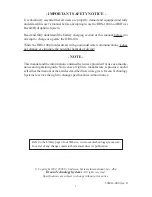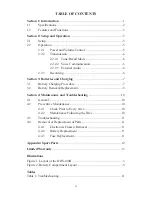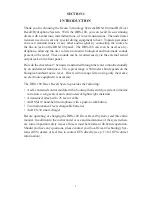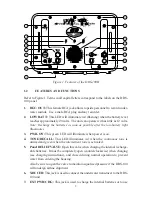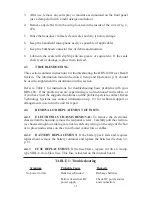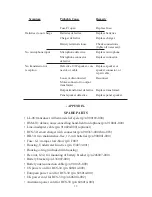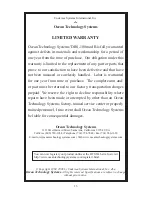
SECTION 3
bATTERIES AND CHARGING
The DRS-100 Diver Recall System is equipped with rechargeable, maintenance-free
batteries (two 12-volt batteries wired in series) and comes with an RCS-30 smart
charger. It is not necessary to remove the batteries to recharge the system.
Note: The battery you receive may have upgraded specifications from what is stated
in this manual. Due to advancing battery technologies, we continually upgrade
our batteries and chargers. Contact OTS (p. 13) or your local OTS dealer to find
out the latest available battery and charger.
The DRS-100 can be powered by an external 24-VDC, 7-amp power source (the
EXT-24 external power supply, sold separately, is available to convert 115 VAC to
24 VDC) or by its internal rechargeable gel-cell batteries. If an external 24-VDC
power supply is used, the internal batteries will partially recharge. The charging
source must provide at least 28 volts, 500 mA for batteries to come to a fully
charged condition.
When the low-battery LED (Fig. 1, #2) begins to flash red, the battery voltage has
decreased to 20 volts. Although the DRS-100 can operate with as little as 12 volts,
we recommend that you recharge the batteries (Section 3.1) as soon as possible
after the LED starts to illuminate. If the batteries no longer hold a charge, replace
them (Section 3.2).
3.1
bATTERY CHARGING PROCEDURE
WARNINg:
To avoid damage or injury, read and follow all the instructions below
before attempting to recharge the batteries.
If you are going to operate the DRS-100 outside the USA, you will need to purchase
the appropriate power cord for the region of operation. Power cords are available
for: Australia (606014-003), UK (606014-002), and Europe (606014-001).
1. Open the cover.
2. Turn the relief valve (Fig. 1, #5) fully counterclockwise to open it.
3. Locate the 24-volt “EXT PWR/CHG” jack (Fig. 1, #7), and insert the plugs
(+ red and – black) from the RCS-30 smart charger.
Note: Be certain that black is connected to black and red to red. If they
are reversed, no harm will occur to the DRS-100, but the batteries will not
charge.
4. Connect the RCS-30 smart charger to any power source providing between
90 and 260 volts AC, 50 or 60 Hz.
5. The red LED on top of the battery charger should illuminate to indicate the
charger is properly connected. The charger may be disconnected when the
7


